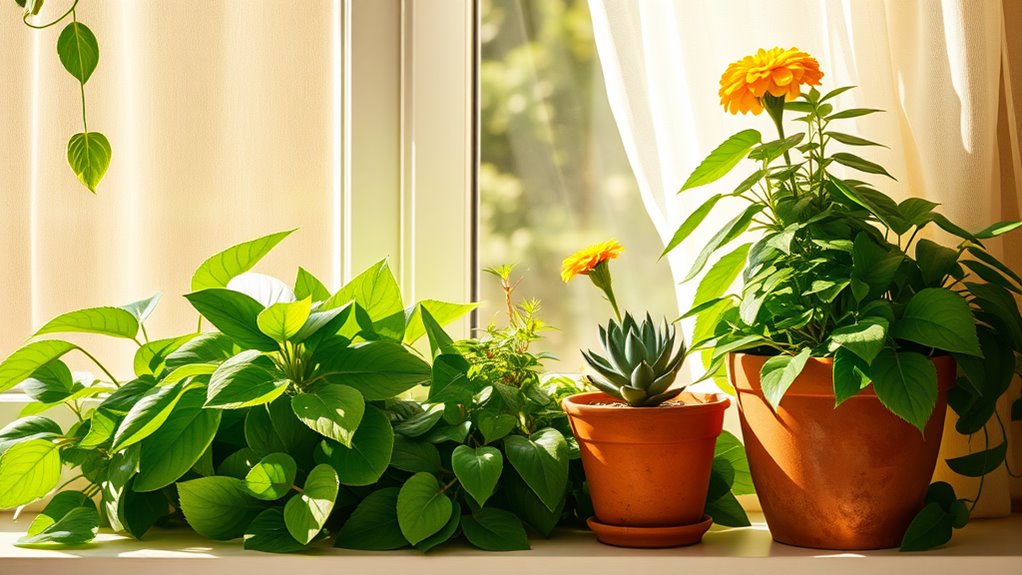Beginner’s Guide to Windowsill Plants-Everything I Wish I Knew Sooner
Did you know that over 70% of indoor plant owners struggle with keeping their windowsill plants healthy? If you’re just starting out, it’s easy to make common mistakes that can lead to yellowing leaves or stunted growth. Understanding the essentials of light, soil, and watering can make all the difference. Let’s explore what you need to know to help your plants thrive in your home.
Choosing the Right Windowsill Plants
When you’re selecting the right windowsill plants, consider the amount of sunlight your space receives, as this will significantly influence your choices.
Bright, sunny locations thrive with succulents and cacti, which love direct light.
If your windowsill has partial shade, opt for ferns or peace lilies, which flourish in lower light.
For those with a mix of conditions, try herbs like basil or mint; they adapt well and add culinary value.
Always ensure proper drainage and soil quality, as healthy roots are vital for thriving windowsill plants.
Additionally, understanding essential care techniques will help you maintain the health and beauty of your plants.
Your careful selection will lead to a vibrant, green sanctuary in your home.
Understanding Light Requirements
Understanding the light requirements of your windowsill plants is crucial for their growth and vibrancy. You’ll need to consider the types of light they thrive in, how long they need it each day, and how seasons can affect their needs. Additionally, many herbs prefer bright, indirect light, which is essential for optimal growth and flavor development.
Types of Light
Light is one of the most crucial factors in successfully growing windowsill plants, and knowing the different types can make all the difference.
There are three primary categories: direct, indirect, and low light.
Direct light offers intense rays, perfect for sun-loving plants like succulents. Indirect light, filtered through curtains or nearby structures, suits many tropical species. Low light, often found in shaded areas, is ideal for resilient plants like snake plants.
Understanding these light types helps you position your plants effectively, ensuring they thrive.
Choose wisely, and your windowsill can become a vibrant green sanctuary that flourishes with life!
Light Duration Needs
How long should your plants bask in light each day? Most houseplants thrive on 12 to 16 hours of light daily.
However, this can vary based on plant type and light intensity. For instance, succulents and cacti prefer longer exposure, while ferns might do well with less.
Monitor your plants closely; yellowing leaves signal too much light, while leggy growth indicates insufficient exposure.
You can use timers for consistency, ensuring they receive the right amount of light.
Remember, quality matters too—bright, indirect light often yields the best results.
It’s crucial to meet their specific light duration needs for optimal health.
Adjusting for Seasons
As the seasons change, so do the light conditions in your home, which can significantly impact your plants’ health.
To ensure your plants thrive, consider these adjustments:
-
Summer: Maximize light exposure; rotate pots to avoid uneven growth.
-
Fall: Gradually reduce light; move plants closer to windows as days shorten.
-
Winter: Supplement with grow lights; many plants need more help during this dark season.
Soil and Potting Essentials
Choosing the right soil is crucial for your windowsill plants’ health, as it directly affects their growth and moisture retention.
You’ll want to master essential potting techniques to ensure your plants thrive in their new environment.
Let’s explore how to set up your greenery for success, starting with the perfect soil mix. Additionally, selecting a soil that supports herb growth can enhance the vitality of your indoor garden.
Choosing the Right Soil
The right soil is crucial for the health and growth of your windowsill plants.
Selecting quality soil can make all the difference.
Here’s what to consider:
-
Drainage: Good drainage prevents root rot, allowing your plants to thrive.
-
Nutrients: Rich, organic soil provides essential nutrients that boost growth and vitality.
-
pH Level: A balanced pH ensures your plants can absorb nutrients effectively, leading to lush, vibrant foliage.
Potting Techniques Explained
Once you’ve selected the right soil, it’s time to focus on potting techniques that will help your windowsill plants flourish.
Start by choosing a pot with drainage holes; this prevents water from pooling and roots from rotting. Fill the bottom with a layer of gravel for extra drainage, then add your soil.
When transferring your plant, gently loosen the root ball to encourage growth. Place your plant in the center, and fill around it with soil, ensuring it’s level with the pot’s rim.
Water thoroughly after potting, and give your plant a cozy spot to bask in sunlight. Happy planting!
Watering Techniques for Success
How can you ensure your windowsill plants thrive through proper watering techniques?
Mastering watering is essential for success.
Mastering the art of watering is crucial for nurturing thriving windowsill plants.
Here are three vital tips:
-
Check Soil Moisture: Stick your finger into the soil. If it’s dry an inch down, it’s time to water.
-
Water Deeply: Ensure water reaches the roots by watering thoroughly until it drains from the bottom.
-
Use Room Temperature Water: Cold water can shock your plants. Warm, filtered water is gentler and promotes absorption. Additionally, incorporating healthy plant practices can significantly enhance your watering routine.
Pest Management and Plant Health
Maintaining the health of your windowsill plants goes beyond proper watering; pest management is key to their overall vitality.
Regularly inspect your plants for signs of pests like aphids, spider mites, or mealybugs.
If you spot any, act quickly—remove them by hand or use a gentle insecticidal soap.
Encourage natural predators like ladybugs, which can help control infestations.
Also, ensure good airflow around your plants, as stagnant conditions can invite pests.
By staying vigilant and proactive, you’ll create a thriving environment, allowing your windowsill plants to flourish and bring life to your space.
Incorporating plants can also enhance overall well-being, making your home not just visually appealing but mentally uplifting as well.
Healthy plants make for a happy home!
Seasonal Care Tips for Windowsill Plants
As the seasons change, so do the needs of your windowsill plants.
Understanding these shifts can nurture your green companions and enhance your space.
Here are three essential seasonal care tips:
-
Winter: Reduce watering; dormant plants require less moisture to avoid root rot.
-
Spring: Repot and fertilize; as growth resumes, your plants need fresh soil and nutrients.
-
Summer: Monitor light exposure; intense sunlight can scorch leaves, so adjust their position as needed.

